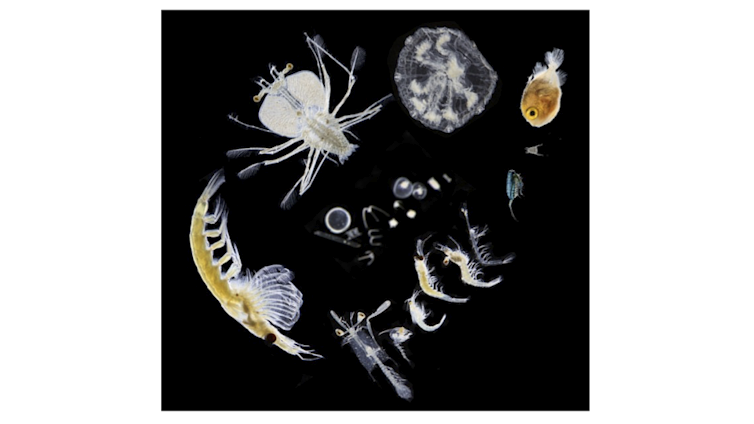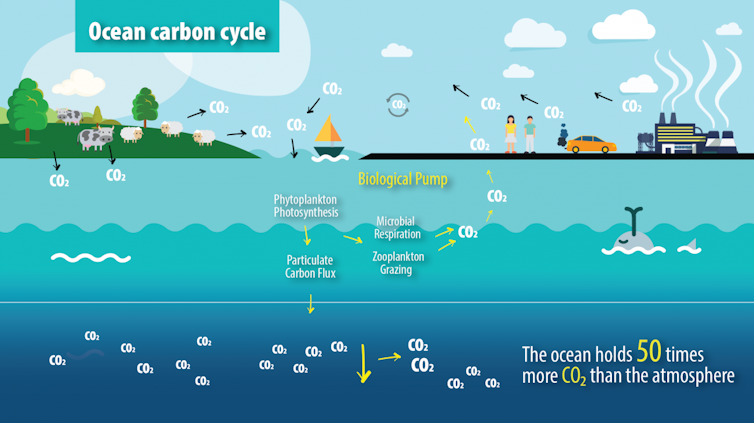As the world struggles to decarbonize, it is becoming increasingly clear that we will need to both rapidly reduce emissions and actively remove carbon dioxide (CO₂) from the atmosphere. The latest report from the Intergovernmental Panel on Climate Change examined 230 pathways to keeping global warming below 1.5°C. All of this required the elimination of CO₂.
Some of the most promising CO₂ removal technologies receiving government funding in the US, UK and Australia aim to increase the massive carbon storage potential of the oceans. These include fertilizing tiny plants and fine-tuning ocean chemistry.
Ocean-based approaches are growing in popularity because they could potentially store carbon for a tenth of the cost of “direct air capture,” where CO₂ is sucked out of the air using energy-intensive machines.
But the marine carbon cycle is much more difficult to predict. Scientists must untangle the many complex natural processes that could alter the effectiveness, efficiency, and safety of ocean-derived CO₂ removal before they can move forward.
In our new research, we highlight a surprisingly important mechanism that had previously been overlooked. If CO₂ removal techniques change the appetites of tiny animals at the base of the food chain, it could significantly change the amount of carbon actually stored.
Plankton dominates the carbon pump
Tiny forms of marine life called plankton play an important role in the ocean carbon cycle. These microscopic organisms drift on ocean currents, moving captured carbon across the seas.
Like land plants, phytoplankton use sunlight and CO₂ to grow through photosynthesis.
Zooplankton, on the other hand, are tiny animals that feed primarily on phytoplankton. They come in many shapes and sizes. If you line them up, you might think they come from different planets.
In all this diversity, zooplankton have very different appetites. The hungrier they are, the faster they eat.
Uneaten phytoplankton – and zooplankton droppings – can sink to great depths, keeping carbon out of the atmosphere for centuries. Some even sink to the bottom of the sea and eventually turn into fossil fuels.
This transfer of carbon from the atmosphere to the ocean is called a “biological pump”. It traps hundreds of billions of tons of carbon in the oceans and out of the atmosphere. This translates to approximately 400 ppm of CO₂ and 5°C of cooling!

Julian Uribe-Palomino/IMOS-CSIRO
Foodies
In our new research, we wanted to better understand how zooplankton appetite influences the biological pump.
We first had to understand how zooplankton appetites differ from ocean to ocean.
We used a computer model to simulate the seasonal growth cycle of the phytoplankton population. This is based on the balance between reproduction and death. The model simulates reproduction very well.
The appetite of zooplankton largely determines the mortality rate. But the model isn’t very good at simulating mortality rates because it doesn’t have enough information about the zooplankton’s appetite.
So we tested dozens of different appetites, then compared our results to real data.
To obtain global observations of phytoplankton seasonal cycles without a fleet of ships, we used satellite data. This is possible even though phytoplankton are tiny, because their light-capturing pigments are visible from space.
We ran the model at more than 30,000 locations and found that zooplankton appetites varied enormously. This means that all of these different types of zooplankton are not distributed evenly throughout the ocean. They seem to gather around their favorite prey.
In our latest research, we show how this diversity influences the biological pump.
We compared two models, one with just two types of zooplankton and one with unlimited numbers of zooplankton – each with different appetites, all individually adapted to their unique environment.
We found a realistic diversity of zooplankton reduced the power of the biological pump by a billion tonnes of carbon each year. This is bad for humanity because most of the carbon that doesn’t go into the ocean ends up in the atmosphere.
Not all of the carbon contained in phytoplankton bodies would have descended deep enough to be retained out of the atmosphere. But even if just a quarter did so, when converted to CO₂, it could equal the annual emissions of the entire aviation industry.

IAEA
The ocean like a sponge
Many ocean CO₂ removal technologies will change the composition and abundance of phytoplankton.
Ocean-based biological CO₂ removal technologies, such as “ocean iron fertilization,” aim to increase phytoplankton growth. It’s a bit like spreading fertilizer in your garden, but on a much larger scale – with a fleet of ships sowing iron across the ocean.
The goal is to remove CO₂ from the atmosphere and release it into the ocean depths. However, because some phytoplankton need iron more than others, giving them iron could change the composition of the population.
Alternatively, non-biological ocean-based CO₂ removal technologies, such as “ocean alkalinity enhancement”, shift the chemical balance, allowing more CO₂ to dissolve in the water before until it reaches chemical equilibrium. However, the most accessible sources of alkalinity are minerals, including nutrients that favor the growth of some phytoplankton over others.
If these phytoplankton changes favor different types of zooplankton with different sized appetites, they will likely change the strength of the biological pump. This could compromise – or complement – the effectiveness of ocean CO₂ removal technologies.
Emerging from an ocean of uncertainty
Emerging private sector CO₂ removal companies will need to be accredited by reliable carbon offset registries. This means they must demonstrate that their technology can:
- remove carbon for hundreds of years (permanence)
- avoid major environmental impacts (safety)
- lend themselves to precise monitoring (verification).
Faced with a sea of uncertainty, now is the time for oceanographers to set the necessary standards.
Our research shows that CO₂ removal technologies that alter phytoplankton communities could also lead to changes in carbon storage, by altering the appetite of zooplankton. We need to understand this better before we can accurately predict how well these technologies will work and how we should monitor them.
This will require enormous efforts to overcome the challenges of observing, modeling and predicting zooplankton dynamics. But the reward is enormous. A more reliable regulatory framework could pave the way for an emerging, morally imperative trillion-dollar CO₂ removal industry.